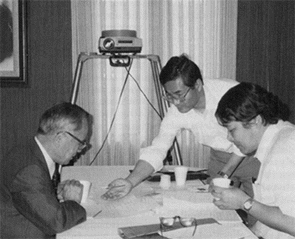Versions of DS86
‘Extending’ DS86 allows dose assessment for about 1,200 survivors in Nagasaki who were shielded in factories and by terrain and for about 10,000 distal survivors who were in the open
by Shoichiro Fujita, Department of Statistics
This article was originally published in RERF Update 1(2):3, 1989.
In March 1986, US and Japanese dosimetry committees approved a new system of dosimetry to replace the tentative system known as T65D, which had been used as a basis for risk assessment until that time. The description of the new system, given the name “DS86,” together with the scientific basis for it, was published by RERF in 1987. Computer codes were developed immediately to implement DS86 on RERF’s NEC ACOS-750 computer. The following describes the versions of this dosimetry system from the inception of computer implementation.

Shoichiro Fujita, center, discusses DS86 with Eizo Tajima, left, and Masaharu Hoshi at the binational dosimetry workshop held in Honolulu earlier this year(1989).
Version 1: DS86 was installed in early 1986 and covered all survivors with detailed shielding histories who were at distances less than 2,500 meters from the hypocenter at the time of the bombings and who were unshielded or shielded by Japanese-style houses or tenements. It enabled the computation of free-in-air tissue kerma, tissue kerma adjusted for the effects of shielding by housing (sometimes loosely called “shielded kerma”), and absorbed doses, all of these for neutron and gamma radiation.
Calculations were possible for males and females; standing, sitting, or in a prone position, in either frontal, rear, right or left orientation; for three age classes (< 3, 3-12, and > 12 years); and for a number of organs (12 for males and 14 for females): active bone marrow, bladder, bone, brain, breast, eyes, intestinal tract, liver, lungs, ovaries, pancreas, stomach, testes, thyroid gland, and uterus. In addition, DS86 allowed the output of energy-dependent fluence distributions for each organ dose component, i.e., prompt gamma radiation and neutrons, delayed gamma and neutron radiation, and secondary gammas from prompt and delayed neutrons created by the shielding and from interactions in the body. It turned out that the system was able to compute kerma and dose for 23,422 of the 28,743 survivors (81%) who had been within 2,500 meters of hypocenter in the ABCC-RERF Master Sample for which detailed shielding data were available. This included 18,526 of the 23,420 survivors (79%) in the Life Span Study (LSS) cohort used in most analyses of radiation effects among A-bomb survivors.
Because DS86 requires the availability of detailed shielding information and only covers survivors within 2,500 meters, it was necessary to “extend” DS86 to enable the assessment of the doses of survivors, at all distances, for which no detailed shielding information was available. The method developed for this purpose became known as the “indirect DS86.” It relies on the use of free-in-air-kerma regression models and the application of average transmission factors for given classes of shielding rather than the individual-specific ones used in the “direct DS86.” The indirect DS86 produces only kerma and dose, as broken down above, but no fluences. Altogether, 71,367 survivors, of whom 57,567 are in the LSS cohort, were added to the number of direct estimates given earlier.
Version 2: Early on, the system was slightly modified to correct software errors in the original version. It produced only minor changes in dose estimates and concerned primarily direct DS86 organ doses for breast, ovary, and uterus in adults and all organ doses for the age group below three. Average transmission factors used in the indirect DS86 were also recalculated. Enhancements to the system permitted calculation of special cases, specifically factory workers and survivors shielded by terrain (all of them in Nagasaki), but these enhancements were not implemented until version 3 was prepared. Therefore, the number of survivors covered did not change between versions 1 and 2.
Version 3: Most recently (in May 1989), kerma and doses for Nagasaki survivors shielded in factories (361) and by terrain (815) were included (all direct DS86). New indirect estimates were made for 10,034 distal survivors who were in the open. Kerma and dose estimates for all Nagasaki survivors were recalculated and slightly reduced (1%) because of modifying the calculation of slant distance from the epicenter to each survivor, which reflects a sea-level correction.
After the latest version, DS86 covers 115,027 survivors for which T65D estimates were available, 93,741 of whom are in the LSS cohort. Eighty-eight percent of the proximal survivors and 97% of the distal survivors now have kerma and dose estimates. Future efforts will be directed to the inclusion of more special cases in the proximal group: those who were shielded in concrete buildings, in air-raid shelters, and in other complex shielding situations. It appears already, however, that this may produce dose estimates for at best 3,000 survivors, and will require considerable effort and time.

